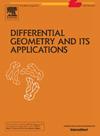经典和量子力学中的时间
IF 0.7
4区 数学
Q3 MATHEMATICS
引用次数: 0
摘要
在这篇文章中,我们研究力学中时间的性质。一个由二阶微分方程支配的机械系统的演化所依据的基本原理,意味着牛顿意义上的绝对时间的存在。对于保守系统,还有第二种时间概念,它使得哈密顿作用以恒定速率演化。在量子力学中,绝对时间失去了它的意义,就像它失去了轨迹的概念一样。然后,我们提出了两种不同的方法来达到与时间相关的Schrödinger方程。一种方法是考虑自由系统的“时间限制”。另一种方法是基于赫兹的观点,把这个系统看作一个自由系统的投影。在后一种方式中,Schrödinger方程中出现的“时间”是时间持续时间与哈密顿-雅可比方程每个解上能量作用的“时间”商的线性组合。它们都基于我们在第4节中解释的量子化规则。本文章由计算机程序翻译,如有差异,请以英文原文为准。
Time in classical and quantum mechanics
In this article we study the nature of time in Mechanics. The fundamental principle, according to which a mechanical system evolves governed by a second order differential equation, implies the existence of an absolute time-duration in the sense of Newton. There is a second notion of time for conservative systems which makes the Hamiltonian action evolves at a constant rate. In Quantum Mechanics the absolute time loses its sense as it does the notion of trajectory. Then, we propose two different ways to reach the time dependent Schrödinger equation. One way consists of considering a “time constraint” on a free system. The other way is based on the point of view of Hertz, by considering the system as a projection of a free system. In the later manner, the “time” appearing in the Schrödinger equation is a linear combination of the time-duration with the “time” quotient of the action by the energy on each solution of the Hamilton-Jacobi equation. Both of them are based on a rule of quantization that we explain in Section 4.
求助全文
通过发布文献求助,成功后即可免费获取论文全文。
去求助
来源期刊
CiteScore
1.00
自引率
20.00%
发文量
81
审稿时长
6-12 weeks
期刊介绍:
Differential Geometry and its Applications publishes original research papers and survey papers in differential geometry and in all interdisciplinary areas in mathematics which use differential geometric methods and investigate geometrical structures. The following main areas are covered: differential equations on manifolds, global analysis, Lie groups, local and global differential geometry, the calculus of variations on manifolds, topology of manifolds, and mathematical physics.

 求助内容:
求助内容: 应助结果提醒方式:
应助结果提醒方式:


